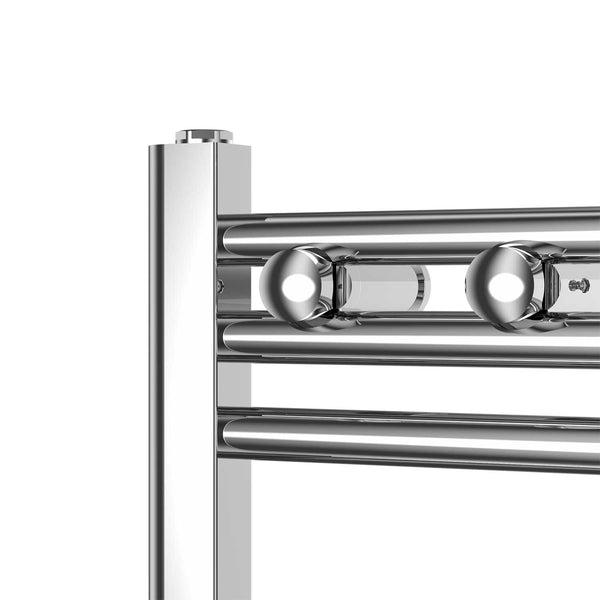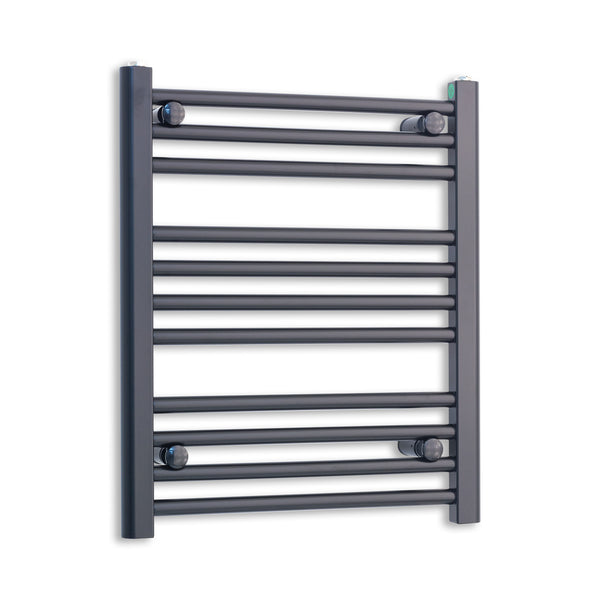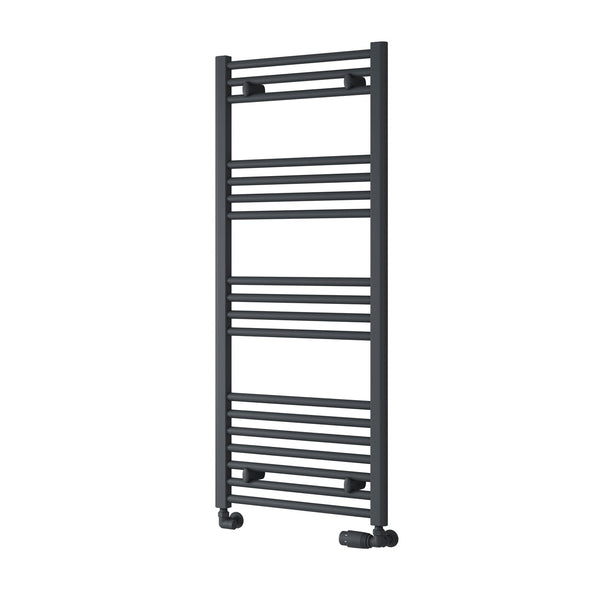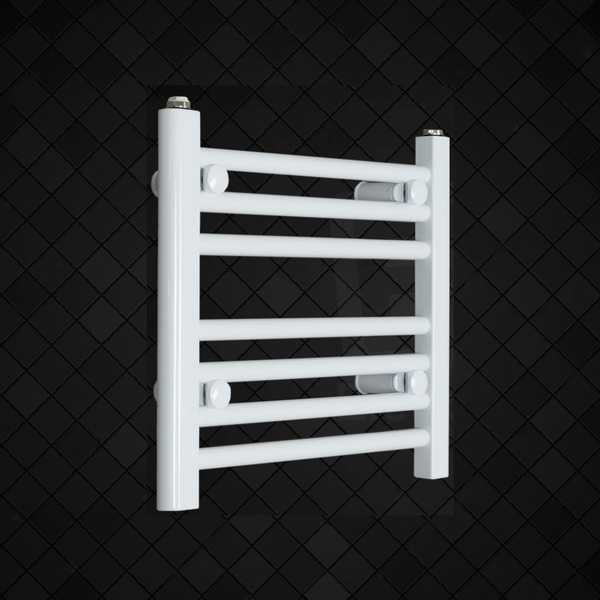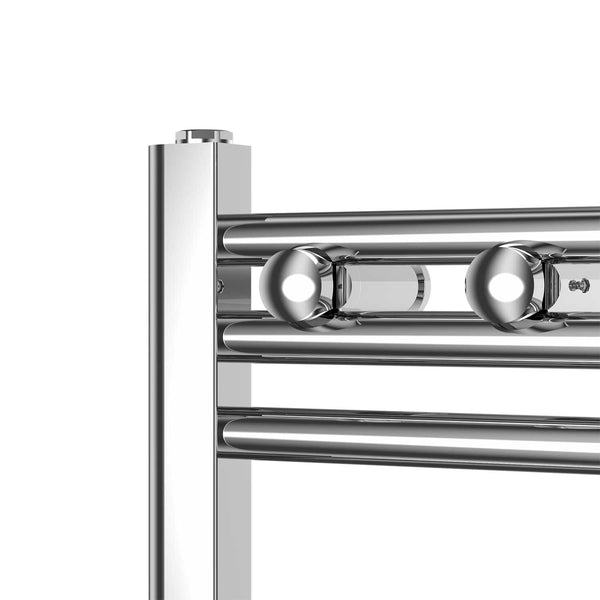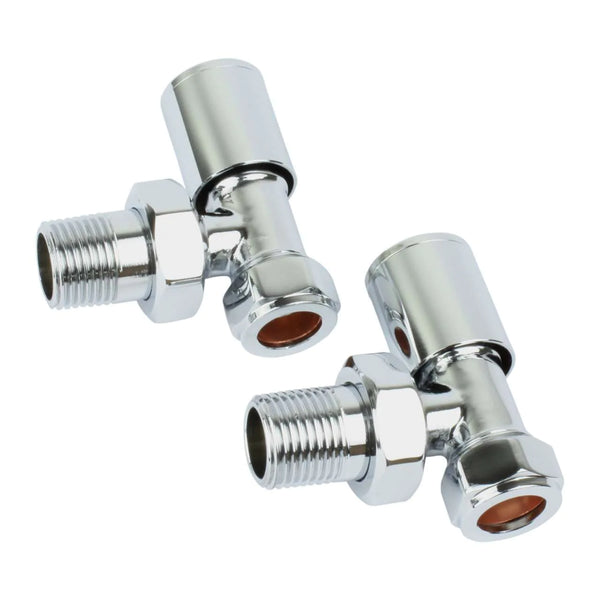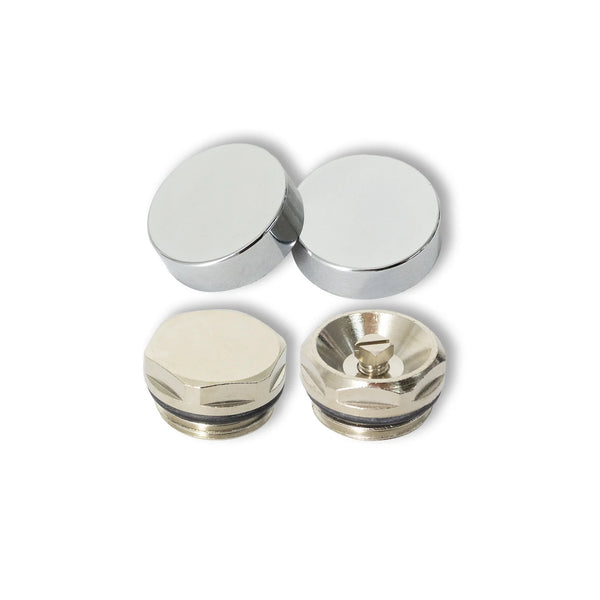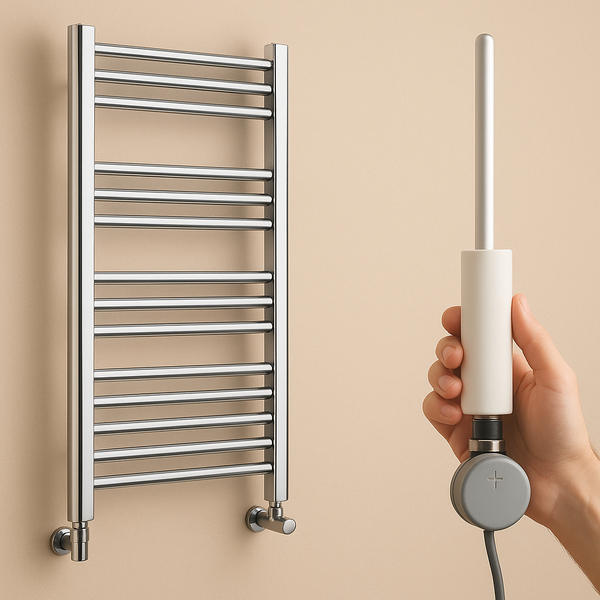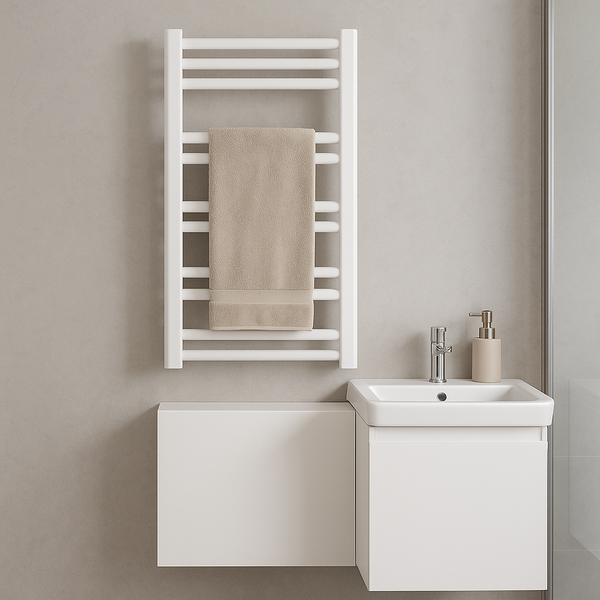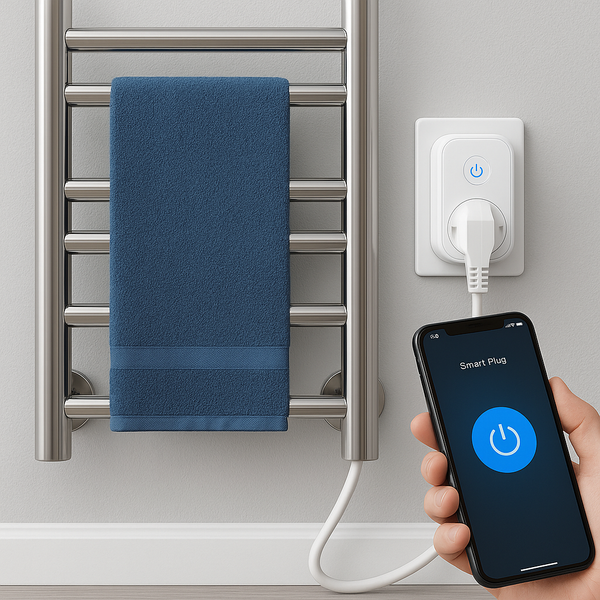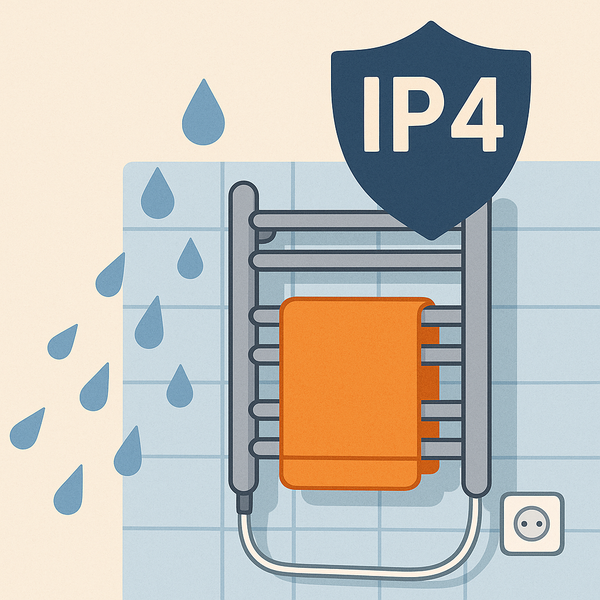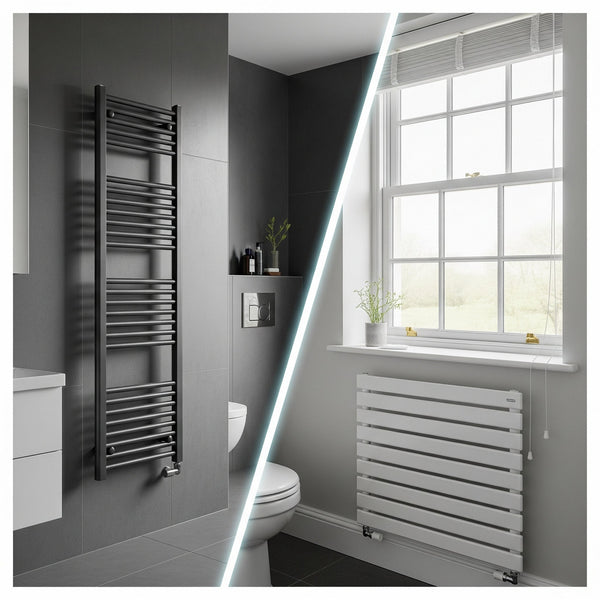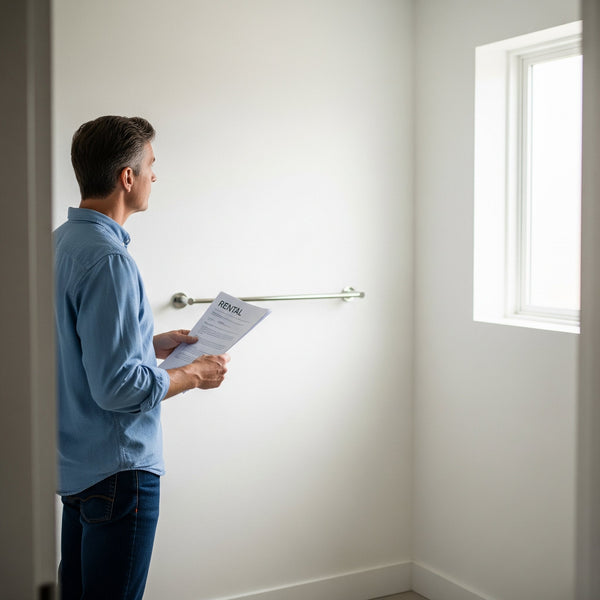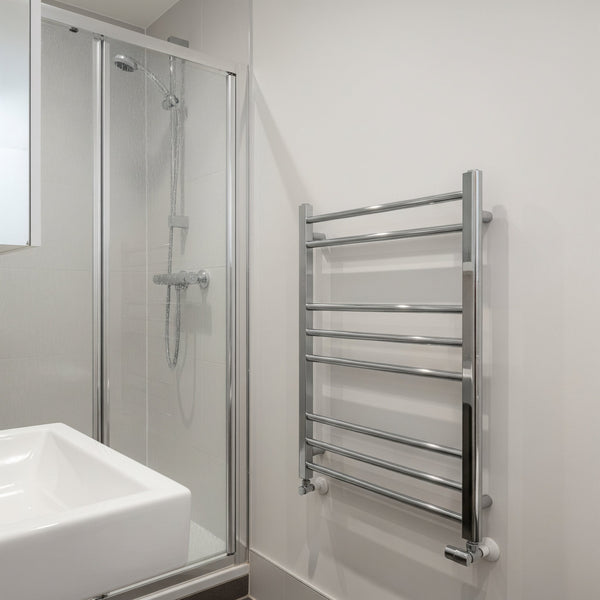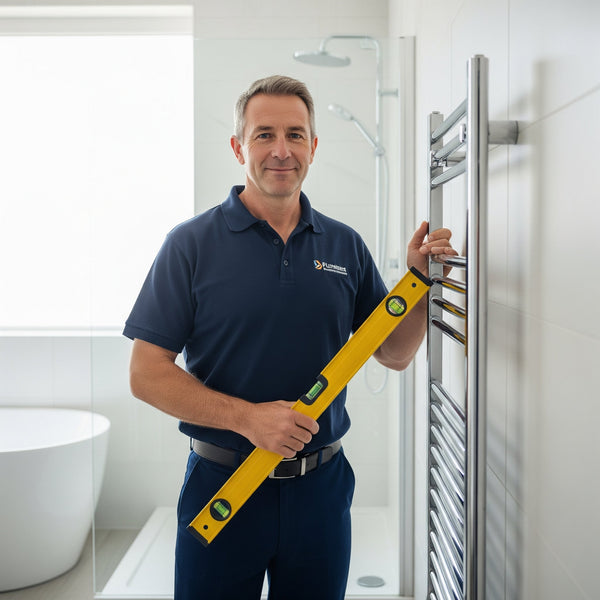Efficient & Stylish: The Benefits of Dual Fuel Towel Radiators

1. Introduction: The Year-Round Quest for Warm Towels & A Cosy Bathroom
For many UK homeowners, the simple pleasure of stepping out of a shower and wrapping oneself in a warm, fluffy towel is a daily highlight, especially on a crisp morning. However, achieving this often presents a dilemma: is it worth firing up the entire central heating system just for the bathroom? This is particularly pertinent during the milder spring and autumn months, or even on those surprisingly cool summer evenings when the main heating has long been switched off. The reluctance is understandable; heating an entire house for the sake of one room feels inefficient and uneconomical. This common scenario highlights a widespread desire among UK households for more granular control over their home comfort, a need that traditional heating systems don't always meet. The inconvenience of damp towels or a chilly bathroom when the central heating is off is a familiar frustration.
Enter the dual fuel towel rail, a versatile and intelligent solution poised to revolutionise bathroom heating. These innovative fixtures offer what many describe as the "best of both worlds" promising year-round comfort without the associated wastefulness of conventional heating methods. They represent an upgrade that enhances not just utility but also the daily experience of luxury and comfort in one of the most important rooms in the home.
This comprehensive guide will delve into the world of dual fuel towel rails, explaining precisely what they are, how their ingenious dual-mode system works, and the multitude of benefits they bring to UK homes. Furthermore, it will explore crucial considerations before purchasing, offer advice on selecting the perfect model for your needs, touch upon installation and smart usage, and provide a brief overview of maintenance and potential running costs. By the end, the aim is to equip homeowners with the knowledge to decide if a dual fuel towel rail is the right heating solution for their bathroom.
2. What Exactly is a Dual Fuel Towel Rail?
At its core, a dual fuel towel rail is a specially designed radiator intended to warm both towels and the bathroom environment. Its defining characteristic is its ability to be powered by two distinct energy sources: it can connect to the home's existing central heating system, functioning like a standard radiator, and it can also operate independently using mains electricity. This dual capability is what sets it apart from other types of heated towel rails.
To appreciate its uniqueness, it's helpful to compare it with its counterparts:
-
Standard (Central Heating Only) Towel Rails: These are plumbed into the central heating system and will only provide heat when the main household heating is active. While efficient in winter, they offer no solution for warm towels or a heated bathroom during warmer months when the central heating is typically off.
-
Electric-Only Towel Rails: These operate independently using an electrical element and can be switched on at any time. However, they cannot take advantage of the central heating system, which, particularly if gas-powered, can be a more cost-effective way to heat during the colder months when the entire house requires warming.
The fundamental advantage of a dual fuel towel rail, therefore, lies in its inherent flexibility. It allows homeowners to leverage the efficiency of their central heating system during the winter and switch to the convenience of electric power during the summer or any other time the central heating is off. This adaptability makes it an intelligent upgrade for many UK homes, building upon the familiar concept of central heating radiators by adding an invaluable layer of independent electrical functionality. The capacity for dual operation isn't a mystical property but rather the result of integrating specific components that facilitate connections to both heating systems, a topic explored in the next section.
3. How Do Dual Fuel Towel Rails Work?
Dual fuel towel rails ingeniously integrate two independent yet complementary heating systems within a single unit. The rail itself is designed with inlets for hot water from the central heating pipes and a port for an electric heating element. A critical design and operational principle is that these two modes central heating and electric are not intended to be used simultaneously. Attempting to do so could lead to inefficiency, system conflicts, or even damage to the components, particularly the electric element.
Mode 1: Central Heating Power
When operating in central heating mode, the dual fuel towel rail functions identically to any other radiator in the house. Hot water, heated by the home's boiler, circulates through the towel rail, transferring heat to its surface and, consequently, to the towels and the bathroom. For this mode to operate correctly:
-
The electric heating element must be switched OFF.
-
The inlet and outlet valves connecting the towel rail to the central heating pipework must be OPEN, allowing water flow.
-
The bleed valve (air vent) should be securely CLOSED.
Mode 2: Electric Power
This mode provides the much-desired independent heating capability, perfect for summer use or for warming the bathroom without activating the entire central heating system. To use the electric mode:
-
The inlet and outlet valves connecting the towel rail to the central heating system must be completely CLOSED. This isolates the towel rail, preventing the electric element from attempting to heat the entire central heating loop or fighting against cold water in the system.
-
The bleed valve should be slightly OPENED. As the electric element heats the fluid within the (now isolated) towel rail, the fluid expands. A slightly open bleed valve allows any excess pressure to escape, preventing stress on the rail's seals and components. This is a crucial step for both safety and the longevity of the unit.
-
The electric heating element is then switched ON at its dedicated switch or controller.
The Key Components That Make It Happen:
The seamless switching and operation of a dual fuel towel rail are made possible by several key components:
-
The Towel Rail: The physical structure, usually made of steel, stainless steel, or aluminium, that radiates heat.
-
Electric Heating Element: This is a purpose-built resistive element that is inserted into one of the vertical tubes (or sometimes a horizontal tube) of the towel rail. It connects to the mains electricity supply and converts electrical energy into heat.
-
Importance of Wattage: The power output of the electric element, measured in watts (W), is critical. It must be appropriately matched to the size and heat output capacity of the towel rail. An element that is too small will struggle to heat the rail effectively, while an overly powerful one could lead to overheating, damage the element itself (burnout), or be inefficient. Manufacturers typically provide guidance on the correct element wattage for their towel rails, often based on the rail's BTU (British Thermal Unit) output. A common conversion is to divide the BTU output by 3.41 to get the approximate required wattage.
-
The 'T-piece' Adaptor: This is a vital plumbing fitting, shaped like the letter 'T'. It allows both a central heating valve and the electric heating element to be connected to the same inlet point on the towel rail. Essentially, one arm of the 'T' connects to the rail, another to the central heating valve, and the third accommodates the threaded connection of the electric element.
-
Radiator Valves:
-
Standard Valves: These are used to control the flow of hot water from the central heating system into the towel rail when it's operating in that mode.
-
Dual Fuel TRV (Thermostatic Radiator Valve): An increasingly popular option is the integrated Dual Fuel TRV. This specialised valve offers a neater and more streamlined installation by combining the functions of a Thermostatic Radiator Valve, a lockshield valve (for balancing the system), and the T-piece connection for the electric element into a single unit. This not only provides a cleaner aesthetic but can also simplify the plumbing. A TRV, whether integrated or separate, enhances control in central heating mode by sensing the ambient room temperature and automatically adjusting the hot water flow into the rail to maintain the desired warmth, thus preventing overheating and saving energy. The choice between a standard T-piece with separate valves and an integrated Dual Fuel TRV can influence both the final look of the installation and potentially its complexity, presenting a decision point for consumers.
Understanding these components and the operational modes is key to using a dual fuel towel rail effectively and safely, ensuring it delivers on its promise of flexible, year-round bathroom comfort.
4. The Best of Both Worlds: Key Benefits for Your UK Home
Dual fuel towel rails offer a compelling array of advantages that cater specifically to the needs and desires of UK homeowners, transforming the bathroom experience from purely functional to one of enhanced comfort and efficiency.
A. Year-Round Comfort & Unwavering Convenience
The most immediate and perhaps most cherished benefit is the luxury of having warm, dry towels available whenever desired, irrespective of the season or whether the main central heating is operational. Imagine stepping out of a shower on a cool summer morning and being greeted by a pre-warmed towel a simple indulgence that elevates the daily routine. This convenience extends to practicalities; dual fuel rails ensure quick towel drying, which is crucial in preventing the unpleasantness of damp towels and the associated growth of bacteria and mildew, a common issue in often humid UK bathrooms. No longer do towels need to be draped over other radiators or left to air dry slowly during warmer months.
B. Energy Efficiency & Potential Cost Savings
The dual-mode operation is central to the energy efficiency claims of these towel rails.
-
Targeted Heating: The ability to heat only the bathroom and towels when needed, without engaging the entire household heating system, is a significant energy saver. This is particularly advantageous in the UK's variable climate, where the bathroom might be the only room requiring a warmth boost. As one source notes, "Turning on your entire central heating system to enjoy warm towels is incredibly wasteful. Dual fuel radiators help you save money on your energy bills by eliminating the need to switch on your central heating system".
-
Summer Savings: During summer, when the central heating (often gas-powered) is typically off, using the more targeted electric option for the towel rail avoids the inefficiency and cost of running the whole system.
-
Winter Efficiency: Conversely, in winter, when the central heating is already warming the rest of the house, the towel rail can operate as part of this system. If the central heating is gas-powered, this is generally a more economical way to provide sustained heat compared to relying solely on electricity. For UK homes with gas central heating, running the towel rail via this system is often the most economical approach during cold periods.
The ability to choose the heating mode provides a sense of control over energy consumption, a powerful motivator given the fluctuations in UK energy prices. While actual savings depend on usage patterns and tariffs, the option to make these choices offers psychological comfort and a proactive way to manage energy use.
C. Unmatched Flexibility & Control
This is the hallmark of dual fuel technology. Homeowners gain the power to select the most appropriate and cost-effective heating source based on their immediate needs and the time of year. This grants independent control over the bathroom's temperature, decoupling it from the heating schedule of the rest of the house. Effectively, this creates a micro-heating zone for the bathroom, aligning with modern trends in smart heating and energy management where users desire more precise control over individual room temperatures.
D. A Stylish Statement in Your Bathroom
Beyond their functional prowess, dual fuel towel rails are available in a vast spectrum of designs, sizes, materials, and finishes. This allows them to serve as an aesthetic enhancement to any UK bathroom, whether the décor is classic, contemporary, or minimalist. Options range from sleek chrome ladder rails to bold matt black designer pieces, with materials including robust steel, corrosion-resistant stainless steel, and fast-heating aluminium. This variety ensures that functionality does not come at the expense of style.
E. Supplemental Heating Boost
In addition to their primary role of warming towels, these rails can provide a welcome supplemental heat source for the bathroom itself. This is especially useful in smaller bathrooms or en-suites where installing a full-sized conventional radiator might be impractical or unnecessary. The extra warmth contributes to a cosier and more inviting atmosphere.
F. Backup Heat Source
An often-overlooked benefit is the resilience dual fuel towel rails offer. In the unfortunate event of a central heating system failure, the electric element can be activated to provide essential warmth in the bathroom, ensuring at least one room remains comfortable.
These combined benefits position dual fuel towel rails not merely as a utility item but as a smart upgrade that can enhance daily comfort, offer greater control over energy use, and contribute to the overall appeal and functionality of a modern UK bathroom. Such a feature can even be a positive selling point when considering the property's value.
5. Before You Take the Plunge: Important Considerations for UK Buyers
While the advantages of dual fuel towel rails are compelling, prospective buyers in the UK should be aware of several important considerations before making a purchase and planning an installation. A clear understanding of these factors will ensure a smooth process and long-term satisfaction.
A. The Upfront Investment
Dual fuel towel rails, along with the necessary components like the electric heating element and T-piece or specialised dual fuel valves, typically carry a higher initial purchase price compared to their single-fuel counterparts (i.e., central heating only or electric only models). Price comparisons indicate that while basic central heating towel rails can start from under £50 and electric-only versions from around £70, dual fuel models generally begin at a higher price point, often £100 or more, reflecting their enhanced functionality and additional components. This initial outlay is a key factor to budget for.
B. Installation: Not Always a Simple DIY Task
The installation of a dual fuel towel rail is inherently more complex than that of a single-fuel unit because it involves both plumbing and electrical work.
-
Plumbing: The unit needs to be connected to the existing central heating pipework, a task that requires plumbing knowledge and skill.
-
Electrical Work: The electric heating element must be safely wired into the mains electricity supply. This is a critical step that, in the UK, has significant safety and regulatory implications.
-
Professional Help is Highly Recommended (Especially in the UK):
-
A qualified plumber is essential for making sound connections to the central heating system, ensuring no leaks and proper integration.
-
A certified electrician is crucial for wiring the electric element. This work must comply with UK Building Regulations, specifically Part P, which governs electrical safety in dwellings. Installations in bathrooms, being 'special locations' due to the presence of water, are subject to stringent rules. A fused spur is typically required for the electrical connection to the towel rail. As sources advise, "A certified electrician may need to do this and have the work signed off for Building Regulations" and electrical work should be left to a professional "unless you're a confident electrician". The need for potentially two different tradespeople (plumber and electrician) can add to the overall installation cost and complexity. This regulatory compliance is not merely advisory but a legal and safety necessity in the UK, potentially affecting home insurance and future property sales if not adhered to.
C. Space, Positioning & UK Bathroom Zones
Careful consideration must be given to the available wall space and the desired size of the towel rail. More critically, the positioning of the unit, particularly its electrical components, must adhere to the IEE Wiring Regulations (BS 7671) concerning electrical zones in bathrooms. These regulations define areas within the bathroom based on their proximity to water sources (baths, showers, basins) and dictate what type of electrical equipment, if any, can be installed in each zone. The towel rail's electrical parts must be sited in an appropriate zone to ensure safety. Additionally, the IP (Ingress Protection) rating of the electrical element should be suitable for the bathroom environment, indicating its resistance to moisture and dust.
D. Understanding True Energy Consumption
While dual fuel towel rails offer the potential for energy savings, their actual impact on energy bills depends heavily on how they are used. If, for instance, the electric element is relied upon extensively during winter when gas central heating (if available) would be a cheaper per-kWh option for sustained heating, bills could increase. The "energy efficiency" benefit is realised through the intelligent and appropriate use of the dual modes, not automatically. As one source cautions, "excessive use of both electric and central heating simultaneously [though not designed for such operation] can lead to higher energy bills. It's essential to use them wisely".
The total cost of ownership is therefore a more complex calculation than a simple price tag comparison. It involves the product price, the potentially significant installation costs, and then weighing these against the perceived long-term benefits of convenience and potential (but not guaranteed) running cost savings. This makes the decision-making process one of considered investment rather than an impulse purchase.
6. Finding Your Perfect Match: Choosing the Right Dual Fuel Towel Rail
Selecting the ideal dual fuel towel rail involves balancing practical heating requirements with aesthetic preferences and desired levels of control. Careful consideration of the following aspects will help UK homeowners make an informed choice.
A. Size Matters: Heat Output (BTU/Watts) for Your Bathroom
The primary function of a towel rail, beyond drying towels, is often to contribute to the bathroom's warmth. Therefore, its heat output capacity is paramount. This is typically measured in BTU (British Thermal Units) per hour.21 A rail that is too small for the bathroom will struggle to heat the space effectively or dry towels efficiently, especially in colder weather. Conversely, an excessively large unit may be unnecessary and less economical. Larger bathrooms naturally require a towel rail with a higher BTU output.
To determine the appropriate BTU for a specific bathroom, it is highly recommended to use an online BTU calculator. Many UK radiator suppliers, including Company Blue, offer these tools. Such calculators typically take into account room dimensions (length, width, height), window sizes, types of walls, and levels of insulation to provide an estimated heating requirement.
Once the required heat output for the rail is known, it's crucial to select an electric heating element with a compatible wattage. An undersized element will result in a lukewarm rail and slow drying, while an oversized one could potentially damage the element through burnout or operate inefficiently. The relationship between BTU and wattage is key; a general rule of thumb is that wattage can be estimated by dividing the BTU output of the rail by 3.41.
To simplify this critical selection, the following table, based on typical industry recommendations, provides guidance on matching electric element wattage to towel rail heat output:
Table 1: Recommended Electric Element Wattage
|
Towel Rail Output (Watts) |
Recommended Element (Watts) |
Approx. BTU Equivalent (Rail Output ÷ 3.41) |
|
165 - 255 |
200W |
484 - 748 BTU |
|
260 - 375 |
300W |
762 - 1099 BTU |
|
380 - 530 |
400W |
1114 - 1554 BTU |
|
535 - 735 |
600W |
1569 - 2155 BTU |
|
740 - 920 |
800W |
2170 - 2698 BTU |
|
920 - 1100 |
1000W |
2698 - 3226 BTU |
Note: Always refer to the specific towel rail manufacturer's recommendations for element sizing.
Getting this calculation right is foundational; an incorrectly sized rail or element can undermine all other choices, regardless of smart features or aesthetic appeal.
B. Style, Material & Finish: Reflecting Your Taste
Dual fuel towel rails are available in a diverse range of styles to suit any bathroom aesthetic:
-
Styles: The most common is the ladder rail, but options include curved fronts, straight profiles, flat panels for a minimalist look, elaborate designer shapes, and more traditional column styles.
-
Materials: Common materials include mild steel (often the most budget-friendly), stainless steel (known for its excellent durability and resistance to rust and corrosion, ideal for humid bathroom environments), and aluminium (which heats up very quickly, offering rapid warmth ). The choice of material impacts not only the look but also thermal properties like heat-up speed and retention, as well as long-term durability.
-
Finishes: A wide array of finishes allows for perfect coordination with other bathroom fittings. Popular choices include polished chrome, classic white, contemporary matt black, sophisticated anthracite, as well as brushed or polished effects.An interesting detail for those maximising heat output is that painted finishes (like white or black powder coats) may emit slightly more heat than chrome finishes, due to the multiple plating layers required for chrome which can act as a slight insulator.
C. Valves: More Than Just On/Off
The choice of valves affects both functionality and aesthetics:
-
Standard Valves: These provide basic on/off control for the flow of water from the central heating system.
-
TRVs (Thermostatic Radiator Valves): When the towel rail is operating in central heating mode, TRVs allow for automatic control of the room temperature. They sense the ambient warmth and adjust the water flow into the rail accordingly, preventing the bathroom from becoming too hot and potentially saving energy.
-
Integrated Dual Fuel TRVs: As mentioned earlier, these offer the neatest installation. They combine the TRV function, the T-piece for the electric element, and the lockshield valve (for system balancing) into a single, compact unit. This eliminates the visual clutter of separate components.
D. Embrace Smart Control: Programmable & WiFi Elements
Modern electric heating elements for dual fuel towel rails can incorporate sophisticated control features, transforming a simple heater into a smart bathroom accessory.
-
Programmable Thermostats: These allow users to set specific heating schedules for the electric mode, ensuring towels are warm precisely when needed, for example, before a morning shower or after an evening bath.
-
WiFi/App-Controlled Elements: The pinnacle of convenience, these elements connect to the home's WiFi network and can be controlled remotely via a smartphone app. This allows users to adjust temperatures, switch the rail on or off, set timers, and monitor energy usage from anywhere. Features often include multiple operating modes such as 'Comfort', 'Night-time', 'Anti-freeze', and 'Boost' for rapid heating.
These smart features represent a significant step up in user control, enabling proactive energy management. They empower users to fine-tune their towel rail's operation to an unprecedented degree, moving beyond simple on/off functionality to truly optimised heating schedules that align with individual lifestyles and can maximise the potential energy savings of the dual fuel system.
7. Making the Most of Your Dual Fuel Towel Rail: Smart Usage & Efficiency Tips
Owning a dual fuel towel rail provides fantastic flexibility, but realising its full potential for comfort and energy efficiency hinges on understanding how to use it correctly and smartly. Adopting good habits will ensure warm towels and a cosy bathroom without unnecessary energy expenditure.
A. Mastering the Switch: Correctly Changing Modes
It is absolutely crucial to follow the correct procedure when switching between central heating and electric modes to ensure safe and efficient operation, and to prevent damage to the unit, particularly the electric element.
-
To use the Electric Mode (e.g., in summer or when central heating is off):
-
Ensure the electric heating element is initially switched OFF.
-
Completely CLOSE both the inlet and outlet valves that connect the towel rail to the central heating system. This isolates the rail.
-
Slightly OPEN the bleed valve (air vent) on the towel rail. This allows any pressure build-up from the expansion of the heating fluid within the isolated rail to be released safely. This subtle step is important for the longevity of the rail's seals.
-
Switch the electric heating element ON using its dedicated switch or controller.
-
To use the Central Heating Mode (e.g., in winter when main heating is on):
-
Ensure the electric heating element is switched OFF.
-
Ensure the bleed valve (air vent) is securely CLOSED.
-
OPEN both the inlet and outlet valves that connect the towel rail to the central heating system, allowing hot water to circulate.
Critical Reminder: Under no circumstances should the electric heating element be active while the central heating valves to the towel rail are open. Operating both simultaneously can cause the electric element to overheat and potentially fuse (burn out), as it would be trying to heat a much larger volume of water or fighting against the central heating flow.
B. Maximising Energy Efficiency in Your UK Home
-
Use Thermostats Wisely: If your dual fuel setup includes a TRV for the central heating mode, set it to a comfortable room temperature (often a setting of 2-3 is adequate) to prevent the bathroom from overheating and wasting energy. If the electric element is thermostatic, use its controls to maintain an optimal temperature for towel drying and bathroom comfort without leaving it on maximum unnecessarily.
-
Timers are Your Friend: For the electric mode, timers are invaluable. Whether using a smart element with built-in programming or a separate smart plug, schedule the towel rail to switch on only when needed – for instance, an hour before your morning shower and for a period afterwards to dry the towel. This avoids constant operation and significantly reduces electricity consumption. Some UK households with Economy electricity tariffs might even use timers to heat the rail during cheaper off-peak hours overnight. Leaving the electric element on 24/7 is generally not cost-effective and negates much of the efficiency benefit.
-
Match Mode to Season and Need: Make a conscious choice based on the time of year and your heating requirements. In winter, if the central heating is already running for the rest of the house and is gas-powered, this is often the more economical mode for sustained bathroom warmth. In summer, or for quick, localised heating at other times, the electric mode is ideal.
User behaviour is the single biggest determinant of actual energy savings. The technology provides the options; diligent management of these options unlocks the efficiency.
C. Understanding and Estimating Running Costs in the UK
-
Electric Mode Costs: The cost of running the towel rail in electric mode can be estimated using a simple formula:
Running Cost (pence) = (Element Wattage in kW) × (Hours of Use) × (Electricity Rate in pence per kWh)
To convert wattage to kilowatts (kW), divide by 1000. For example, a 600W element is 0.6kW.
Average UK electricity rates fluctuate, but as of May 2025, a typical rate was around pence per kWh.16 It is vital to check current electricity tariffs for accurate calculations.
Table 2: Example Running Costs for Electric Mode (Per Hour)
|
Element Wattage |
Approx. Cost per Hour (at 27p/kWh) |
|
150W |
~4.1p |
|
300W |
~8.1p |
|
600W |
~16.2p |
|
900W |
~24.3p |
|
1000W (1kW) |
~27.0p |
Note: These are illustrative costs. Actual costs will vary based on your specific electricity tariff and usage duration.
-
Central Heating Mode Costs: When operating via the central heating, the cost is incorporated into the overall household heating bill. For homes with gas central heating, this is generally a more economical source of heat per kWh for prolonged periods compared to standard rate electricity in the UK.
-
Impact of Thermostatic Elements: It's important to note that if the electric element has a thermostat, it will cycle on and off to maintain the set temperature. Therefore, its actual energy consumption over several hours might be less than if it were running at its full rated wattage continuously. The costs in Table 2 represent the cost if the element is actively heating for the full hour.
By making the energy source a conscious choice, dual fuel towel rails can encourage more mindful energy use, potentially leading to broader awareness of heating habits and costs.
8. Keeping it Gleaming & Efficient: A Quick Look at Maintenance
Proper maintenance will ensure your dual fuel towel rail continues to operate efficiently, look its best, and provide years of reliable service. Most maintenance tasks are straightforward:
-
A. Regular Cleaning:
Dust and water spots can detract from the appearance of your towel rail. Clean the surfaces regularly using a soft, damp cloth. For more stubborn marks, a mild, non-abrasive cleaning solution diluted in water can be used. It is crucial to avoid harsh chemical cleaners or abrasive scouring pads, as these can damage the finish, whether it's chrome, paint, or another specialist coating. After cleaning, always dry the rail thoroughly with a soft, dry cloth to prevent water spots and streaks, especially on polished chrome finishes. -
B. Bleeding the Radiator (Central Heating Mode):
If you notice that the towel rail has cold spots, particularly at the top, when it's operating in central heating mode, this usually indicates trapped air within the system. Trapped air reduces heating efficiency. To resolve this, the rail needs to be 'bled'. This is typically done by using a radiator key (or sometimes a flat-head screwdriver) to slowly open the small bleed valve located at the top of one of the rail's sides. Hold a cloth underneath to catch any drips. A hissing sound will be heard as the air escapes. Once water begins to seep out instead of air, close the bleed valve securely. This procedure is primarily relevant when the rail is part of the wider central heating circuit. -
C. Checking for Leaks:
Periodically inspect the valves, the connections to the pipework, and the points where the heating element enters the rail for any signs of leaks or weeping. Even small leaks can lead to water damage, corrosion, or a drop in system pressure over time. If any leaks are detected, they should be addressed promptly. This might involve gently tightening a connection (being careful not to over-tighten) or, for more persistent issues, seeking professional plumbing assistance. -
D. Valve Maintenance:
Ensure that the central heating valves (and TRV, if fitted) operate smoothly. TRVs, if left in the closed or very low position for extended periods (such as over the summer when the central heating is off), can sometimes stick. To prevent this, it's good practice to turn TRVs to their fully open position when the central heating system is not in use for a long duration. -
E. Central Heating System Inhibitor (UK Specific):
While not maintenance for the towel rail itself, the health of the entire central heating system impacts all connected radiators. In the UK, it is standard practice and highly recommended to maintain the correct concentration of a chemical corrosion inhibitor in the central heating system's water. This inhibitor helps to prevent internal corrosion, the formation of sludge, and limescale build-up, all of which can impair heating efficiency and damage components, including your dual fuel towel rail when it's in central heating mode. Failure to use an inhibitor can sometimes invalidate radiator warranties.
These simple maintenance steps, performed regularly, will contribute significantly to the longevity and sustained efficiency of your dual fuel towel rail, ensuring it remains a valuable and effective feature in your bathroom.
9. Troubleshooting Common Hiccups
Even with the best care, occasional minor issues can arise with dual fuel towel rails. Many of these can be resolved with simple checks, often stemming from incorrect setup or operation rather than a fault with the unit itself.
-
Electric heating not turning on:
-
Solution: First, ensure the towel rail is correctly set to electric mode: central heating valves fully closed, bleed valve slightly open. Check the fused spur or circuit breaker that supplies power to the element. If the problem persists, there might be an issue with the element itself or its wiring, which would require a check by a qualified electrician.
-
Rail not hot enough (in either mode):
-
Solution (Electric Mode): Check the thermostat setting on the element, if it has one. Ensure the element's wattage is correctly sized for the towel rail; an undersized element will struggle.
-
Solution (Central Heating Mode): Check the TRV or manual valve settings are sufficiently open. Bleed the radiator to release any trapped air, as this is a common cause of cold spots. Ensure the boiler is functioning correctly and the overall central heating system is balanced.
-
Rail too hot (electric mode) or making unusual noises (e.g., kettling):
-
Solution: If the rail is excessively hot in electric mode or making noises like a kettle boiling, double-check that the bleed valve is slightly open. If it's fully closed, pressure can build up as the internal fluid heats and expands, leading to these symptoms.
-
Leaks from valves or connections:
-
Solution: Small drips can sometimes be resolved by gently tightening the leaking connection or valve nut. Be careful not to over-tighten. If the leak persists or is more significant, the valve washer may need replacing, or there could be a more serious issue requiring a plumber.
-
Gurgling noises from the rail (central heating mode):
-
Solution: This is almost always a sign of trapped air within the radiator. Bleeding the rail as described in the maintenance section should resolve this.
Important Disclaimer: While these tips can help with common minor issues, any troubleshooting that involves electrical wiring or significant plumbing adjustments should always be carried out by a qualified and certified professional. Safety must be the priority. Proactively addressing these common user errors through clear guidance can significantly improve the user experience.
10. Are Dual Fuel Towel Rails Worth It for UK Homes?
After exploring the functionality, benefits, and considerations, the question remains: are dual fuel towel rails a worthwhile investment for UK homes? The answer, for many, is a resounding yes, though it depends on individual priorities and circumstances.
Dual fuel towel rails offer an undeniable package of flexibility, year-round comfort, and the potential for more efficient energy use when managed correctly. The ability to have warm towels and a cosy bathroom in summer without firing up the entire central heating system is a significant draw, particularly in the UK with its notoriously variable weather patterns and strong reliance on seasonal central heating. This adaptability aligns perfectly with a growing desire among UK homeowners for greater control over their energy consumption and home comfort.
The primary drawbacks are the higher initial cost of the unit and the more complex installation process, which typically requires the expertise of both a plumber and a certified electrician.4 These upfront costs need to be weighed against the long-term advantages.
For many UK households, the value proposition is strong. The convenience of on-demand warmth, the prevention of damp towels, the stylish addition to bathroom décor, and the supplemental heating boost often justify the initial investment. When used intelligently, particularly with thermostatic controls and timers, dual fuel towel rails can indeed contribute to a more economical way of heating the bathroom throughout the year. They represent a "long-term investment in both superior quality and energy efficiency for the home".
Dual fuel towel rails are particularly well-suited for:
-
Homeowners undertaking bathroom renovations or new builds, where the installation can be planned from the outset.
-
Those seeking greater control over their bathroom heating, independent of the main household system.
-
Families or individuals who value the comfort and hygiene of consistently dry towels.
-
Anyone frustrated by a chilly bathroom or damp towels during periods when the central heating is switched off.
Ultimately, the "worth" of a dual fuel towel rail is a personal calculation. For a rarely used guest en-suite, the additional expense might be harder to justify. However, for a busy main bathroom, the daily convenience and enhanced comfort can make it an invaluable addition. The key is to assess one's own needs, usage patterns, and budget against the comprehensive benefits these versatile heaters provide.
11. The Smart, Flexible Choice for Modern UK Bathrooms
Dual fuel towel rails stand out as a genuinely innovative solution in home heating, truly offering the "best of both worlds." They seamlessly blend the robust power of a home's central heating system with the targeted precision and on-demand convenience of electric heating. This duality makes them an exceptionally smart and flexible choice for modern UK bathrooms, catering to the desire for year-round comfort without compromising on energy consciousness.
By providing the ability to isolate bathroom heating from the rest of the household system, dual fuel towel rails empower homeowners with greater control, helping to avoid the inefficiency of heating an entire house just for one room, especially during milder weather. This considered approach to energy usage, combined with the aesthetic versatility and the simple luxury of always having a warm towel ready, positions them as an intelligent investment. Such an investment can lead to a more comfortable, efficient, and stylish bathroom environment, enhancing daily routines and potentially adding value to the home.
A comprehensive understanding of their operation, coupled with smart usage habits and appropriate selection, ensures that a dual fuel towel rail can be a highly rewarding addition to any UK home.
We encourage you to explore the extensive range of dual fuel towel rails available from Company Blue. Should you require personalised advice on choosing the perfect model for your specific needs, or wish to understand more about the installation requirements for your UK home, please do not hesitate to contact our team of experts. Further information and related products can also be found on the Company Blue website.
Frequently Asked Questions (FAQ)
-
Q1: Can I install a dual fuel towel rail myself in the UK?
-
A: While some aspects of the plumbing might be undertaken by a very experienced DIYer, the electrical connection of the heating element must be carried out by a qualified and certified electrician in the UK. This is to ensure compliance with Building Regulations (specifically Part P) and for absolute safety in a bathroom environment. Professional installation for both the plumbing and electrical components is strongly recommended.
-
Q2: How much do dual fuel towel rails cost to run?
-
A: Running costs are variable. When operating in central heating mode, the cost is part of your main heating bill (if using gas, this is often cheaper per kWh for sustained heating). In electric mode, the cost depends on the wattage of the heating element, the duration of use, and your specific electricity tariff (refer to Table 2 in this guide for illustrative examples). Utilising timers and thermostatic controls is key to managing and minimising running costs in electric mode.
-
Q3: Do I need special valves for a dual fuel towel rail?
-
A: You will require standard radiator valves for connection to your central heating system. Additionally, a 'T-piece' fitting is necessary to allow both a central heating valve and the electric heating element to be connected to the rail. A more integrated and neater alternative is a specialised 'Dual Fuel TRV' (Thermostatic Radiator Valve), which combines these functions into a single unit.
-
Q4: Can I convert my existing central heating towel rail to dual fuel?
-
A: In many cases, yes. Most standard towel rails that are part of a central heating system can be converted to dual fuel functionality. This typically involves purchasing a dual fuel conversion kit, which includes an appropriately sized electric heating element and a T-piece. It's crucial to select an element with the correct wattage for your specific towel rail. Professional assistance, particularly for the electrical wiring, is still strongly advised for such conversions.
-
Q5: What size (BTU/Wattage) dual fuel towel rail do I need for my UK bathroom?
-
A: The required size depends on several factors, including the dimensions of your bathroom, the number of external walls, window sizes, and insulation levels. It is best to use an online BTU (British Thermal Unit) calculator – Company Blue provides one on their website – to get an accurate estimate of the heat output needed. Once you know the required BTU, you can choose a towel rail that meets this and then select an electric heating element with a compatible wattage (see Table 1 in this guide for guidance).
-
Q6: Is it cheaper to leave an electric towel rail (or a dual fuel rail in electric mode) on all the time?
-
A: Generally, no. Leaving an electric heating element on continuously is usually not the most cost-effective approach. It's more economical to use it only when needed, ideally controlled by a timer to switch on before use (e.g., for showers) and a thermostat to maintain a set temperature without constant full-power operation. This targeted usage helps to significantly reduce unnecessary electricity consumption.
